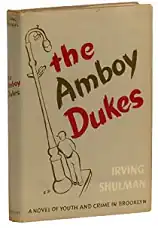The Amboy Dukes (novel)
The Amboy Dukes is a 1947 novel by Irving Shulman, his first.

The novel concerns the misadventures of a 1940s Jewish street gang of young toughs based on Amboy Street in the working class Brownsville section of Brooklyn (Brownsville, from its founding into the 1950s, was a primarily Jewish neighborhood).[1] The gang, characters, and most of the story are fictional, but a key event of the novel – the murder of a high school teacher by two gang members – was based on an actual case.[2]
The Amboy Dukes was considered somewhat outré, unsavory, and shocking for its time, as it depicts its teenage juvenile delinquent protagonists fighting, smoking marijuana reefers, cutting class, using foul language, carrying homemade zip guns, having sex, abusing girls, and being generally vicious.[3] It was sometimes banned from schools.
The book sold five million copies in the 1940s and 1950s[4] and was made into a 1949 movie City Across the River.[2]
Amboy Dukes characters appear in Shulman's next two novels. Cry Tough (1949) has Amboy Duke Mitch Wolf return from prison and get involved with organized crime. In The Big Brokers (1951), Mitch and former Dukes Bull and Larry get deep into syndicate operations in Las Vegas. Eighteen years later in 1973, Shulman published his last novel, The Devil's Knee, which feature Larry and Bull eighteen years later, at first retired from crime and living straight, but forced by the mob to get involved in various escapades.
The novel inspired the name of the 1960s–1970s American rock band The Amboy Dukes (at one remove, because bandleader Ted Nugent, unfamiliar with the book, took the name from a defunct Detroit band because he liked it).[5] A mid-to-late 1960s British band from Nottingham was also named Amboy Dukes.[6] An actual Brownsville street gang of the 1950s named themselves the Amboy Kings.[4]
Later editions
The hardback first edition featured an anodyne line drawing on its cover. Following editions, however, were in paperback and featured various lurid scenes.
References
- "Brownsville, Brooklyn: Blacks, Jews, and the Changing Face of the Ghetto (book description)". University of Chicago Press. Retrieved March 12, 2023.
- "City Across the River". AFI Catalog. American Film Institute. Retrieved March 12, 2023.
- "The Amboy Dukes (review)". Kirkus Reviews. Retrieved March 12, 2023.
- George Merlis (February 6, 1972). "Brooklyn's Amboy Street Is Now Nobody's Turf". New York Times. Retrieved March 12, 2023.
- "BROWNSVILLE and EAST NEW YORK, Brooklyn". Forgotten New York. June 13, 2005. Retrieved March 12, 2023.Gary Johnson (September 30, 2011). "AMBOY DUKES". Michigan Rock and Roll Legends - MRRL Hall of Fame. Retrieved March 12, 2023."How They Got Their Name". Classicbands.com. Retrieved March 12, 2023.
- Nick Warburton (September 14, 1971). "The Amboy Dukes' gigs 1965-1970". Garage Hangover. Retrieved March 12, 2023."Amboy Dukes". Soulbot UK. Retrieved March 12, 2023."Amboy Dukes* – Turn Back To Me". Discogs. Retrieved March 12, 2023.